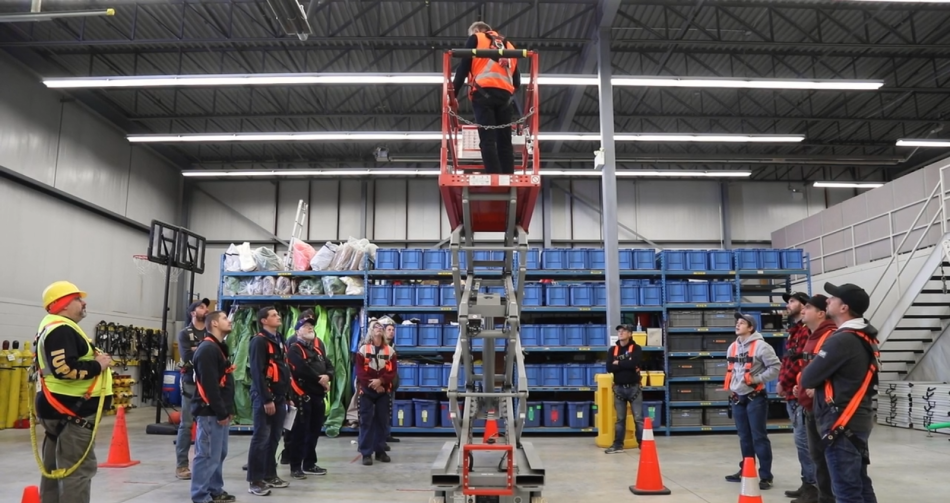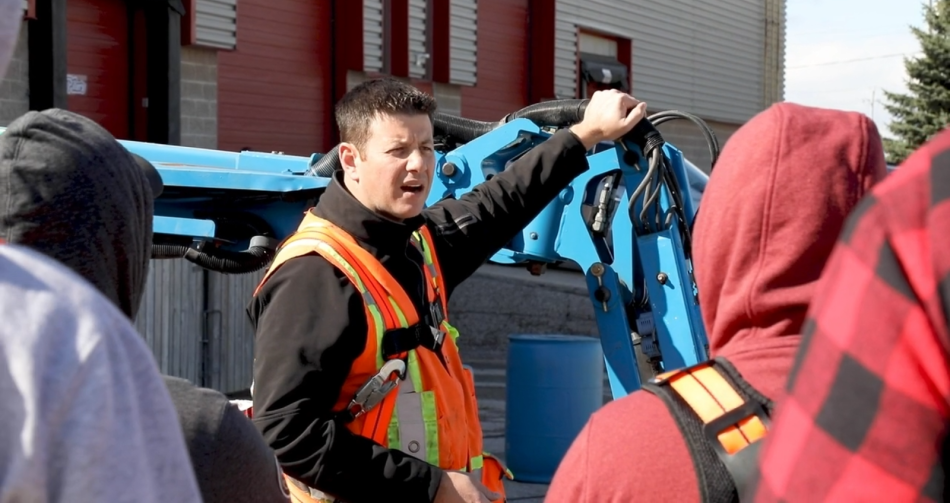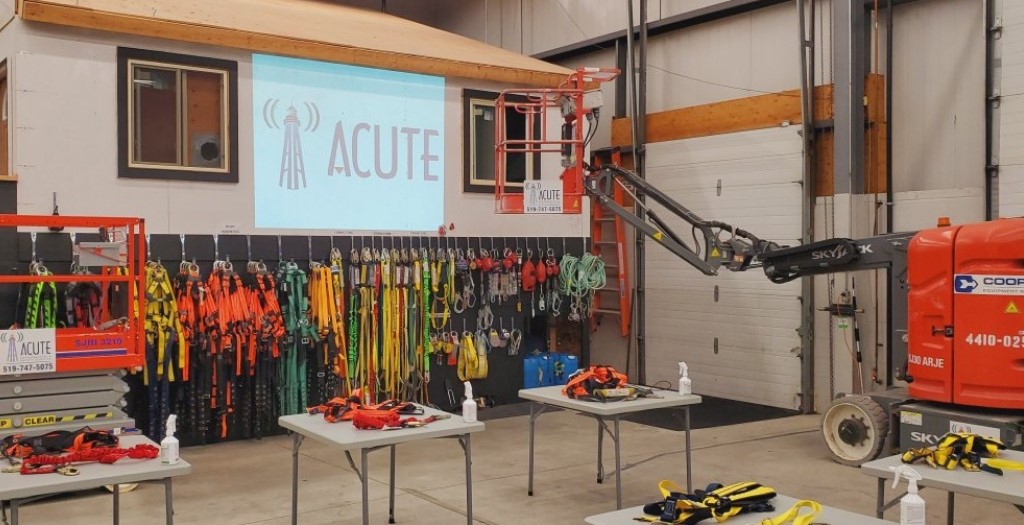Elevated work platform training is a course that is designed to prepare you to safely use and operate elevated work platforms. An elevated work platform refers to a hydraulically, electrically, or mechanically controlled device that is used to elevate workers or materials. To learn more about this type of training and its importance, click on the following linked sections.
- Examples of Elevated Work Platforms
- What Are the General Guidelines for Elevated Work Platform Training
- Specific Guidelines for Construction and Industrial Sectors
- Why EWP Training Is Important
- Working at Heights vs Elevated Work Platform Training
If you would like to take an elevated work platform training course, contact us today.

Elevated work platform training will keep you safe on the job
1. Examples of Elevated Work Platforms
There are many different types of elevated work platforms including:
- Scissor lifts
- Articulated boom lifts
- Individual personnel lifts
- Self-propelled lifts
- Manual “push-around” lifts
- Elevating rolling work platforms
- Self-propelled elevating work platforms
- Boom-type elevating work platforms
- Vehicle-mounted aerial devices
- Aerial work platforms
Most types of elevating work platforms are designed with an emergency stop button that you can use to instantly disable it from any unwanted or accidental operation.

There are many different types of elevated work platforms
2. What Are the General Guidelines for Elevated Work Platform Training?
The Ministry of Labour, Immigration, Training and Skills Development has the following general guidelines for elevated work platform (EWP) training for workers in industrial establishments, construction projects, and those working in live performance workplaces. These include:
- If you will be operating an EWP, you need to get information and instruction on how to safely run and operate the particular class of device that you will be using. Your training program needs to include information about the manufacturer’s instructions.
- It is recommended that you take training refreshers periodically to make sure that you can competently operate your device.
- You need to keep a copy of your proof of training at your workplace, either on your person or in a convenient location nearby.
- Your employer should also keep a record of your training at your workplace.

The Ministry of Labour, Immigration, Training and Skills Development gives general guidelines about EWP training
3. Specific Guidelines for Construction and Industrial Sectors
Construction:
If you use an elevated work platform on a construction project, here are your specific training requirements:
Your employer needs to make sure that you complete a CPO-approved Working At Heights training course* delivered by a CPO-approved trainer.
Your employer must keep a record of your completed training, and be willing to provide records to an inspector if needed.
Your employers must make sure that if you use fall protection equipment, you are adequately trained to use fall protection equipment. Workers must be given adequate oral and written instructions provided by a competent person.
Before you use EWPs, you must be given adequate oral and written instruction on how to properly operate your machinery. You must also be trained to operate the specific class of EWP they will be using in the workplace.
Your Elevating work platform training must include:
- The manufacturer’s instructions
- Instructions regarding load limitations
- Instructions regarding proper use of all controls AND a hands-on demonstration
- Instructions regarding the limitations on the kinds of surfaces the EWP is designed to be used on.
- Your training should also include information about the specific workplace hazards you may face and an evaluated demonstration by the worker showing safe operation skills.
*Note: EWP training is not the same as WAH training, but is also beneficial
Source – Ontario Ministry of Labour, Immigration, Training and Skills Development
Industrial:
If you work in the industrial sector, here are specific training requirements for using an EWP:
Before wearing protective equipment or devices (for example, fall protection equipment), you need to receive information and instruction on how to use it and care for it.
An EWP or lifting device can only be operated by a competent person or by a worker who is accompanied by a competent person.
Source – Ontario Ministry of Labour, Immigration, Training and Skills Development

You need to receive proper instruction before using an EWP
4. Why EWP Training Is Important?
Proper elevated work platform training is vital in keeping your workers safe on the job. According to the Ministry of Labour, Immigration, Training and Skills Development, an employer needs to provide elevated work platform training and hazard awareness to their employees.
Training: An operator of an EWP needs to be trained and supervised in order to protect their health and safety
Hazards: The employer also needs to “acquaint a worker or a person in authority over a worker with any hazard in the use of an EWP and in the handling, storage, use and transport of the EWP”

EWP will help to keep you safe at your workplace
5. Working at Heights Vs Elevated Work Platform Training
Completing a certified Working At Heights training course is legally required for those working from heights on construction projects. Unlike Working At Heights (WAH) training, elevated work platform training does not require the same certification.
There is also no official expiry for elevated work platform training. For best safety practices, it is recommended that workers receive elevated work platform training or refresher training every year to ensure the safety of workers, employers, supervisors, and everyone else in the workplace.
However, there are different certification requirements and obligations for elevated work platforms under the OHSA and the Construction Projects Regulation. Click here to read more about those requirements.
Unlike WAH training, companies cannot be MLITSD certified specifically for elevating work platform training. Still, there are many specific requirements outlined by the MLITSD and OHSA to ensure workers are properly trained.

Working at heights training is legally required for those working from heights on construction projects
Elevated Work Platform Training: The ACUTE Difference
At ACUTE we understand that each workplace is different and has specific hazards. That’s why our EWP training is often specifically tailored to your workplace.
Our training has both a theory and a practical component. During the theory component, you will learn about all classes of elevating work platforms. The practical component, however, only covers the type of EWPs you will actually be using in your workplace.
Anyone who works with or around elevating work platforms should complete this training course. This includes those in supervisory positions.
During our Elevated Work Platform training course we:
- Take the time to look at legislation and how it can vary from workplace to workplace
- Train you on how to recognize the hazards you need to look for and how to inspect and safely use your equipment.
- Take the time to get comfortable with using these machines in our training facility or at your work location
- Will assign multiple instructors to sessions to make sure that the participants are given the attention they need for the devices so that we don’t feel rushed doing it.
ACUTE offers great EWP training to keep you safe
More Reasons to Choose ACUTE
You can trust ACUTE for the best safety training possible. ACUTE’s experienced team members have been serving safety professionals for over 20 years. You can rely on ACUTE for hands-on, physically distanced, practical safety training to keep your employees safe in the workplace.
ACUTE is dedicated to workplace safety and understands the importance of course and training provider approval.
Why get workplace safety training with ACUTE? Here are just some of the benefits of working with ACUTE:
- Open Door Instructor-Student Partnership – ACUTE’s training services emphasize client participation. Staff foster relationships with clients and serve as a touchstone for advice anytime moving forward.
- Serving Your Team and Industry – With a vast array of clients in the manufacturing, construction, health, academic, and government sectors, ACUTE brings the best safety practices from across the spectrum to your workplace.
- Track Record of Success – ACUTE is rated 4.9/5 stars on Google reviews, demonstrating a commitment to our clients, quality, and passion for training.
What Our Customers Are Saying…
“Amazing instructors and trainings! Highly recommended!”


